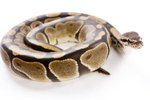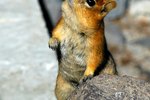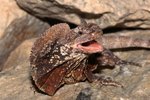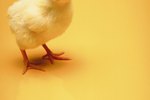Leucistic pine snakes are a color variation of southern and northern pine snakes; both varieties are subspecies of Pituophis melanoleucus. They're large, slow-moving constrictors native to the southeastern United States. Leucistic pine snakes are non-venomous, calm-natured and seldom bite unless goaded. Snake enthusiasts desire pet leucistic pine snakes for their unusual rose color and gentle personalities.
Physical Description
Leucistic pine snakes can be pale pink or white with light, rose-colored patches on their backs. Their eyes are dark, not the pink or red color of an albino's eyes. Their small heads are slightly triangular-shaped, and they have an enlarged rostral scale above their somewhat pointy snouts. Melanoleucus mugitus, the southern sub-species of pine snakes, can reach 6 to 9 feet in length; Melanoleucus melanoleucus, the northern sub-species, averages 4 to 7 feet long.
Natural Habitat
Pine snakes live in soft, sandy areas of pine forests, a mixture of pine and oaks, sandy open areas and deserted fields. They spend most of their time underground, in burrows previously dug by gopher tortoises and pocket gophers, or in self-dug burrows. Southern pine snakes are native to southeastern Alabama, Florida, southern and central Georgia and southwestern South Carolina. Northern pine snakes are natives of South Carolina, northern Georgia, Tennessee and Virginia.
Tank Requirements
Leucistic pine snakes require a minimum tank size of 30 gallons, at least 4 feet by 2 feet, preferably larger. Good airflow and a secure lid are essential. They like a deep substrate to burrow in, and at least two hiding areas -- one in a cool part of the tank and one in a warmer place -- achieved by strategically placing branches and rocks. Provide a large water bowl, cleaned daily, for soaking.
Temperature and Lighting
A tank temperature of 75 to 80 degrees Fahrenheit with a 90-degree basking area is ideal. Use a heating pad designed for reptiles under one-third of the tank, and a UVB heat lamp for basking. Pine snakes require a normal day and night cycle, having 10 to 12 hours of UVB light and 12 hours of darkness. A ventral heat source, such as a heat rock, can help prevent egg-binding in pregnant females.
Adults
Wild pine snakes live underground from early fall until late spring. They emerge in April or May, and surface activity continues until September or October. When threatened, they hiss loudly, vibrate their tails and inflate their bodies. The environment for captive leucistic pine snakes should mimic their natural habitat as much as possible. Mist them periodically with water during their molting periods. Leucistic pine snakes have an average lifespan of 15 to 20 years.
Captive Breeding
Leucistic pine snakes reach sexual maturity when they're about 3 years old, and they breed once a year. Lower the tank temperature to 50 or 55 degrees Fahrenheit for 8 to 12 weeks, simulating winter, to prepare for captive breeding. After normal temperatures are resumed the pine snakes emerge from their burrows. They soon shed their skins and begin mating shortly after.
Eggs to Hatchlings
After 38 to 50 days, females deposit seven or eight eggs in an underground burrow. They often lay their eggs in a communal nest. No parental care is provided after egg-laying.The eggs are 3 to 4 inches long and weigh about 4 ounces. The eggs begin hatching in 60 to 68 days. Southern leucistic pine hatchlings are 18 to 25 inches long; northern leucistic pine hatchlings are 12 to 16 inches long.
Diets
Feeding takes place in a separate tank to prevent ingestion of the substrate matter. Leucistic pine hatchlings and juveniles are fed pinkie mice and rats every three to four days. As they grow feed them larger prey, such as rats, pocket gophers, baby cottontails and other rodents. Adults should be fed weekly.
References
Writer Bio
Karen Mihaylo has been a writer since 2009. She has been a professional dog groomer since 1982 and is certified in canine massage therapy. Mihaylo holds an associate degree in human services from Delaware Technical and Community College.





